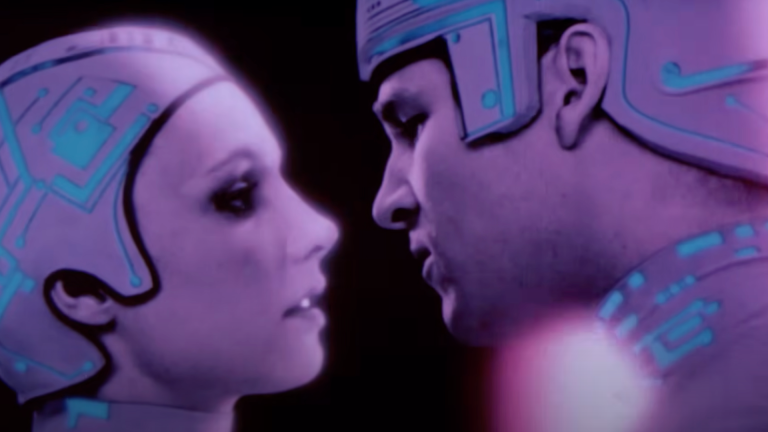Tron Highlighted the Era of Weird Disney
Tron: Ares is a reminder of a time when Disney didn't have it all figured out.

When Jared Leto rides his light cycle into the world this weekend, he rides it into a cinematic landscape that’s very different from the one that introduced his predecessor. Today, Disney is synonymous with safe, formulaic entries. It’s Marvel movies earn millions by following a simple, tried and true formula, one that they cannot shake even when box office earnings point to signs of fatigue. The studio makes easy money by recycling animated movies such as Beauty and the Beast and Lilo & Stitch into CGI animated films with live actors. Critics may hate these retreads, but they never fail to do business.
In short, Disney today is bland, safe, and succesful. None of those words applied to the Disney of 1982, when writer and director Steven Lisberger created Tron with Bonnie MacBird. In 1984, the studio was still in a period of decline, having lost its way after the death of founder Walt Disney and then of his son Roy. Intercompany squabbling and a rotating group of executives meant that Disney put out some of its strangest projects—projects that aren’t good, exactly, but are far more interesting than most of their current offerings.
Something Strange This Way Comes
The first sign of the era’s experimentation was The Black Hole from 1979. Like Star Trek: The Motion Picture, which hit screens just two weeks before it, The Black Hole earned a green light because executives hoped to share in some of the financial success of Star Wars; but, also like Star Trek, The Black Hole took its cues from 2001: A Space Odyssey, which Kubrick released a decade earlier. It puts visual spectacle and a medatative tone over the whizz-bang adventure that George Lucas provided.
Directed by Gary Nelson from a script by Gerry Day and Jeb Rosebrook, The Black Hole follows the starship Palomino deep in its long-term mission, as it discovers a black hole on its return trip to Earth. Within the hole, the crew meets lost family members and a mad scientist (Maximilian Schell), who believes the phenomenon contains secrets to explore. Only the inclusion of a cute R2-D2-esque robot called V.I.N.CENT. takes the edge off the movie, which earned the first PG rating in Disney history.
The Black Hole experimented with CGI graphics, which became the chief draw of Tron, released three years later. Inspired by the advent of video games, Lisberger and MacBird came up with the story of a programmer (Jeff Bridges) who gets sucked into a computer world, where the freedom fighter Tron (Bruce Boxleitner) battles against the dictatorial MCP and its henchman Sark (both portrayed by David Warner).
Even today, Tron looks incredible. The bright neon colors pop against the papery-greyscale of the computer world, and the film’s crisp sound design makes it feel ethereal, even to viewers well acquainted with computers and AI.
Just over two months earlier, Disney released another strange genre project to theaters, Something Wicked This Way Comes. Based on the novel by Ray Bradbury, who provided the screenplay that Jack Clayton directed, Something Wicked This Way Comes is a horror-tinged fantasy story about two boys (Vidal Peterson and Shawn Carson) who do battle with a malevolent figure called Mr. Dark (Jonathan Pryce). Mr. Dark has come to their town with a carnival that promises wonders, but in fact captures the townspeople.
Something Wicked This Way Comes boasts an incredible cast. Beyond the aforementioned Pryce, the film also has Jason Robards as one of the boys’ father, Pam Grier as Mr. Dark’s other associate the Dust Witch, and Diane Ladd as the other boy’s mother. Moreover, it has a genuinely creepy tone, an eerie sense of dread that feels even more stark than Goosebumps or other later projects designed for young viewers.
While Tron and The Black Hole made a profit, Something Wicked This Way Comes was a complete flop with audiences. Further, Tron and The Black Hole both were nominated for Academy Awards, but received mixed notices from critics at the time. And yet, decades later, they remain reminders of a better era for cinema.
The Black Hole of Mediocrity
It should come as no surprise that all three of these movies have become cult favorites. Obviously, Tron has spawned two legacy sequels and an animated series, while The Black Hole was a favorite in the months following the launch of Disney+ and the addition to the service of Something Wicked This Way Comes last week generated online excitement.
Nor should it come as a surprise to learn that none of these films are that great. Visuals aside, all three suffer from plodding pacing and wooden acting, even by folks such as Bridges and Pryce, who have done excellent work elsewhere. They work best as either artifacts from an earlier age of special effects or as nostalgia plays for adults who were young and didn’t know better when they first watched them (like this writer!).
But these films shouldn’t be disregarded either, precisely because of what they say about Disney. Today, it’s hard to imagine Disney as anything other than the behemoth it’s become, a studio that churns out familiar products filled with plays to the past–products that include Tron: Ares. Surely, Disney’s box office fortunes will turn and it will have to get desperate again, resulting in a new wave of oddities.
Until then, we have Tron, The Black Hole, and Something Wicked This Way Comes, movies that aren’t good, but are interesting and are worth remembering.
